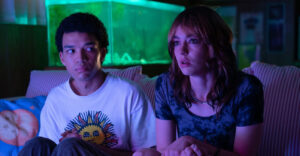I Saw the TV Glow (2024) review
Dir. Jane Schoenbrun
By: Steve Pulaski
Rating: ★★★½
I Saw the TV Glow opens with Owen (Ian Foreman), clearly a lonely seventh grade boy adrift in a sleepy suburb in 1996. He’s fascinated by a show called “The Pink Opaque” on the Young Adult Network, but it comes on past his bedtime, strictly enforced by his mother (Danielle Deadwyler). At school, he notices an older girl named Maddy (Brigette Lundy-Paine) reading an episode guide of the show. He asks his mother if he can spend the night at a friend’s house, and when she agrees, he cuts through several yards to Maddy’s home where he watches “The Pink Opaque” with her and her friend. As surreal images of the show’s oddly entrancing mix of innocent-looking human characters and grotesque creatures flicker across the bright glow of the TV screen, illuminating an otherwise dimly lit, dingy wood-paneled basement, Owen finds himself arrested, enthralled even.
Fast-forward a couple years and I Saw the TV Glow shifts to an older, teenaged Owen (now played by Justice Smith, exceptionally so), who is silently struggling with his own identity, sexuality, and existence, all of which feel ambiguous to him. Defining Owen’s formative years are the death of a loved one, his inconsistent friendship with Maddy, and his undying love and obsession with “The Pink Opaque.”
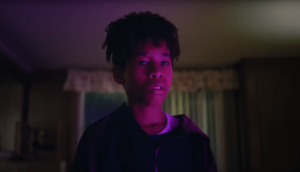
Because Owen still isn’t allowed to stay up late enough to watch the program, and sneaking out to his friend’s house every night is infeasible, Maddy kindly records each episode of the show on a VHS tape. She leaves them for him to find in the school’s dark room. Owen watches each episode in a trancelike state, eyes glazed and his breathing stifled.
“The Pink Opaque” series arc winds up becoming integral to the film’s story as well. The story involves two telepathically linked teenage girls (played by Helena Howard and Lindsey Jordan) fighting a different, heinous villain every episode; the monsters sent by the “Big Bad,” a moon-shaped monster known as “Mr. Melancholy.” There’s an unmistakably nineties quality to the show, and its pastiche suggests The Adventures of Pete & Pete and Buffy the Vampire Slayer. One doesn’t need to look too deeply to notice that Owen and Maddy see themselves as the two teenage girls in the program. Owen even has vivid dreams and flashbacks of himself wearing one of the lead’s outfits, which may or may not have happened.
“I think I like TV shows,” Owen tells Maddy when she asks him if he likes girls, or maybe boys. “When I think about that stuff, I feel like someone took a shovel and dug out my insides. I know there’s nothing there, but I’m still too nervous to open myself up to check.”
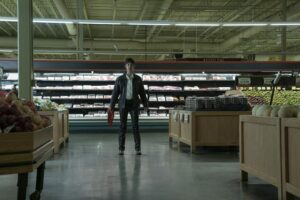
Director Jane Schoenbrun asserted themselves with We’re All Going to the World’s Fair in 2022, a sparse picture that drew on images evidently inspired by creepypasta; a film that didn’t seem to care much about coherence and instead favored aesthetic boldness. Their subsequent work feels defined and impacting.
I Saw the TV Glow is a movie that illustrates the “egg crack,” a term that’s used to describe the instance in a trans person’s life where they realize their identity doesn’t correspond with their assigned gender. Maddy cracks when exposed to “The Pink Opaque,” and following her multi-year disappearance, reemerges to tell Owen that there is an escape from the ennui that plagues him. However, it involves a terrifying, ritualistic-like process that could result in death. It might be a metaphor or it be literal; Owen isn’t sure how to take Maddy’s words. But it could end up being the most beautiful and life-changing move Owen could make at a critical point in his life.
Owen and Maddy probably couldn’t explain why they detest the manicured existence of their suburban enclave, but they feel enough resentment towards it to want something greater. Consider the fact that Owen’s family is shown to be one of the only Black families in the area. “The Pink Opaque” and television as a medium inspires Maddy to revolt against her suburban hellscape and the lies within. Owen isn’t quite sure how to digest the images he’s being fed — images that suggest a broader purpose and a more welcoming world in which he would like to live — so he reverts back to his introverted, closed-off self, continuing to believe that passivity will bring him some kind of contentment in his depressingly shallow existence.
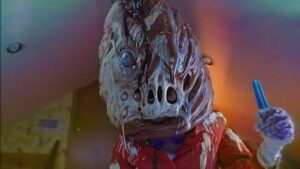
A transgender person themselves, Schoenbrun’s voice and vision is confident, clear, and powerful. Eric K. Yue’s cinematography draws on nightmarish horror imagery that incorporates analog horror. “The Pink Opaque” feels like a real program given its textures, and the way the glow of the TV screen casts a pink hue on the rooms in which it’s viewed almost illustrate its impact on its viewers, Owen and Maddy, as something truly tangible. Yue’s work really comes to shine late in the film, when we see an older, even more detached Owen working at one of those “fun centers” where kids birthday parties are held. Here he is trying to manufacture happiness while the environment around him looks like a nightmare despite it being tailored to children. Owen’s lips are chapped, his ribcage sunk, and his face gaunt. He’s dying a slow, painful death and still feels ill-equipped to confront his own discomfort in his skin.
Even the film’s soundtrack is trying to tell you something, with music from King Woman, The Weather Station, yeule contributing to the soundtrack with lyrics debatably as important as the dialog itself. One of the best numbers is a song by Sloppy Jane and Phoebe Bridgers called “Claw Machine,” haunting in its sound and visceral in its lyrics, every line a couplet in a larger, melancholic poem.
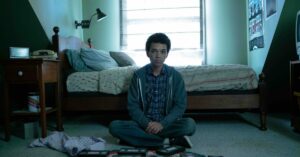
For me, I Saw the TV Glow is an profound examination of the transgender experience through a divinely articulated allegorical lens — something that could help many on the outside of the community in understanding various individuals’ plights sympathetically. For others, young or old, struggling with identity and gender dysphoria, this could be something as significant as a call to action. For Schoenbrun, it’s perhaps the most painful yet personal story they will ever make. Its complexities may run deep, but its messaging is concise and brilliant; the work of a visionary who is just getting started.
NOTE: I Saw the TV Glow is available to rent on multiple platforms.
My review of We’re All Going to the World’s Fair
Starring: Justice Smith, Brigette Lundy-Paine, Helena Howard, Lindsey Jordan, Danielle Deadwyler, Fred Durst, Conner O’Malley, and Ian Foreman. Directed by: Jane Schoenbrun.
About Steve Pulaski
Steve Pulaski has been reviewing movies since 2009 for a barrage of different outlets. He graduated North Central College in 2018 and currently works as an on-air radio personality. He also hosts a weekly movie podcast called "Sleepless with Steve," dedicated to film and the film industry, on his YouTube channel. In addition to writing, he's a die-hard Chicago Bears fan and has two cats, appropriately named Siskel and Ebert!


